
|   |

|   |
Suvarna Sakhi - Chandra Anand e-mail: chandra6267@yahoo.co.in Photos courtesy: Atharvotsava September 16, 2024 50 golden years, a reason to celebrate one's birthday, is to honour and show gratitude to the parents, siblings and spouse for the unconditional support they have given over the years, so that the person can reach this stage of life with success and satisfaction. Shamal Pawar is a law graduate and a HR professional and also a stalwart in the field of dance with knowledge of Bharatanatyam and folk dance. She is not only a performing artiste but also a teacher having trained hundreds of students in the art of dance since 28 years. She is the founder of 'Atharva School of Fine Arts', a registered Performing Arts institute (2003) with Maharashtra state government sanctioned grant (2017). Her vision is to bring out the talent in young children through systematic and technical teaching of dance. She holds a two day dance event 'Atharvotsava' which also has been given Maharashtra state government grant. Shamal Pawar started learning Bharatanatyam at the age of 10 under Dr Ambika Vishwanath. Later, she joined Nalanda Dance Research Centre where she completed Parangata course and diploma in nritya shastra successfully, following which, she underwent training in abhinaya from Dr. Kanak Rele. She continued taking guidance and training for further facilitation in dance and nattuvangam under Guru S.P. Srinivasan and presently for nattuvangam under Dr.V. Bharadwaj. She also got trained under eminent gurus like Dr.Saroja Vaidyanathan, Kiran Subramaniam, V. Balagurunathan and Madurai R. Muralidharan. She recently completed her M.A in Bharatanatyam from Tamil University, Tanjavur. She is also trained in Indian Folk dance under maestros like Late Indumati Lele and Sadanand Rane. She has written a dissertation paper on folk tradition titled 'Dashavatar - the traditional folk theatre of Konkan Maharashtra', under the guidance of Dr. Marie Stella, in part fulfilment of the requirements for the award of MA degree in Bharatanatyam. Her students have passed with first class and distinction honours at the Akhil Bharatiya Gandharva Mahavidyala exams. Many of them have performed on Doordarshan, national and international festivals. The best way to celebrate was with a Bharatanatyam programme with Shamal herself dancing a whole margam after 27 years. She decided to share the stage along with students and close friends. A margam presentation on August 18, 2024 at Mysore Association, Mumbai was arranged with Mala Sridhar, Secretary of the Fine Arts Society, Chembur as the chief guest and Vaagayekara P.S. Krishnamurthy as the guest of honour. 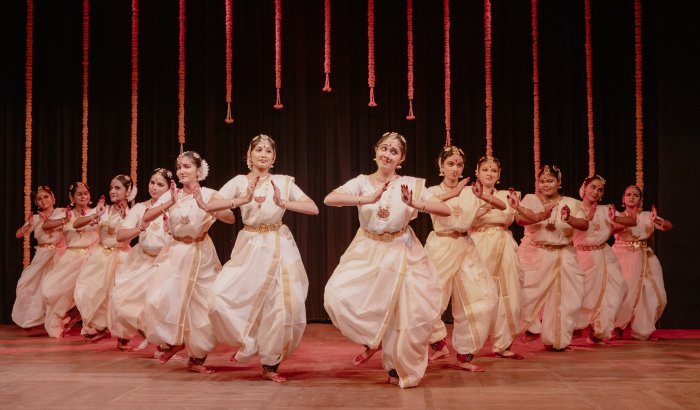 Atharva ensemble The program started with a shloka of Lord Ganapathi by singer Keerthana Krishnamurty. The senior students of Atharva School of Fine Arts commenced the presentation with Ganapathi Shlokam, followed by Kali Stuti Alarippu (Revati, mishrachapu) showing characteristics of Goddess Kali with her weapons and vehicle. The alarippu was also interspersed with shloka from Kali Tandava stotram. On the whole, this presentation projected raudra rasa very natural to Goddess Kali. Tirtha Patange, Shruti Kadam, Sonali Pawar, Sandili Pawar (daughter of Shamal Pawar), Shruthi Kurma, Dia Suvarna, Tanmayee Pendulkar, Akanksha Randhir, Ruchi More, Hritija Prabhu, Tanvi Kothekar and Tanvi Makwana performed it amazingly well. 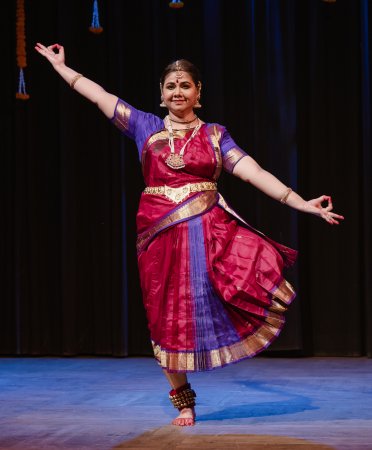 Shamal Pawar Shamal Pawar performed four items of the margam - the jathiswaram (Kanada, adi), a Tanjore Quartet composition; varnam (Nattakuranji, adi), a Papanasam Sivan composition; a keertanam, Ksheera sagara shayana (Devagandari, adi), a composition of Saint Tyagaraja; and padam, Aduvum solluval (Saurashtram, adi), composition of Vaideeswarankoil Subbarama Iyer. The spring in her steps while doing the swara patterns of varnam showed how much she loved dancing. The smile of joy and happiness was very evident. The stories in the varnam and padam were briefly shown. The characters were aptly performed. She transitioned smoothly from one character to the other. It was truly abhinaya oriented and no theatrical gimmicks were involved. And, in the padam, the mature way she handled the sakhis and explained to them about the girl who turned snobbish after getting rich was superb. Her performance affirmed that the traditional margam was safe in her hands and her students. For the rest of the margam presentation, she introduced her friends who joined in the performance at her request to celebrate her birthday. 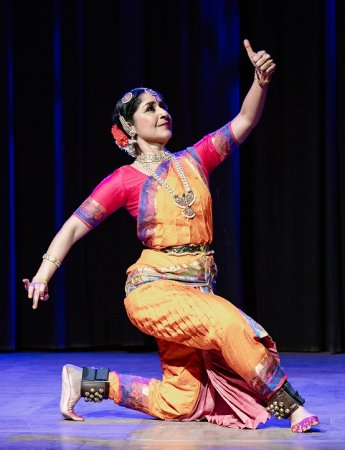 Sujatha Ramanathan Sujatha Ramanathan, a CA by profession and an ex-banker, now is a full-fledged performing artiste and choreographer. She was inspired and encouraged by Shamal on many occasions through her journey of dance. "She's one who has been a strong force of encouragement through my artistic journey, words fail me and hence I dance," said Sujatha. She performed a kriti, Ramam ravikulaambudhi somam shrta jana paripalam karunalavaalam (Mohana Kalyani, rupakam) composed by P.S. Krishnamurthy. It was based on Lord Rama. Sujatha enamoured by deep significance of Lord Vishnu and his avatars and the force behind the name of Rama as explained by Lord Shiva in Vishnu Sahasranamam, started the item with a connect to Shiva and Rama. Through the course of the kriti, she showed Rama's beauty being appreciated by one and all, his breaking of the Shiva danush, Jatayu moksham, Vali yuddham and Ravana moksham. She ended with the verse from Vishnu Sahasranamam. A jathi interspersed in-between was chosen from the recent compilations of Kamala Rani. She was expressive and flexible, with clear execution, but the piece (it was a premiere) could be made crisp and shorter. 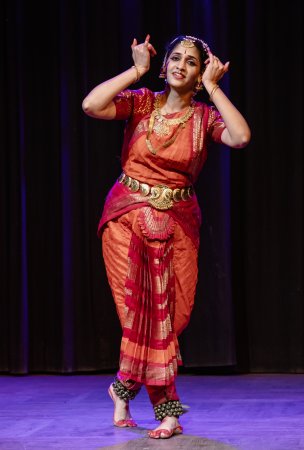 Lakshmi Raj Lakshmi Raj, who took Shamal's guidance for her Visharad exams of the Akhil Bharathiya Gandarva Mahavidyalaya exams, performed a kriti Sri Rama Saraswati (Nasamani, adi), composed by Muthuswami Dikshitar. She began the item with nritta performance to rhythmic pieces of a sollukattu and a swaram set. In the kriti she depicted Devi Lakshmi and Devi Saraswati preparing the idol of Lalithammbika to do pooja to her. They adorn her with jewellery and clothing. For her nose ring they pluck a star. The idol was then turned towards the audience. It showed that Goddess Lalithambika is happy with Lakshmi's and Saraswati's alankaram of her. They are joined by other minor goddesses in their veneration of the wife of Lord Shiva. She ended the item dancing to the dhyana shlokam on the Devi from Lalitha Sahasranamam. Performed to recorded Kuchipudi music, all depiction was done with apt gestures, stances and expressions. Her tall form and smiling face along with graceful dancing captivated the audience. 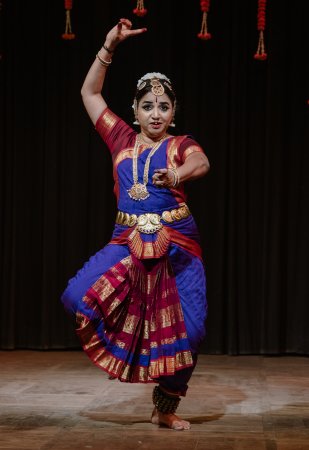 Lakshmi Ananthanarayanan Lakshmi Ananthanarayanan, who did her masters in dance along with Shamal at the Tamil University, performed Jaya Maruti Kavuthvam (Panthuvarali, adi) composed by Madurai R Muralidharan. This piece glorifies Hanuman, also known as Maruti, the personification of victory and embodiment of wisdom, righteousness, generosity, and virtue. The item started with Lord Rama looking for Sita and Hanuman says he will help. The shloka started suddenly. The story of Hanuman going in search of Sita by crossing the ocean and exchanging Rama's ring for Sita's choodamani was embedded in the shloka itself. "Having meditated, he rose like a fiery flame and crossed the swirling sea waves and paid his respects to Goddess Sita." The shloka also says the effects of Hanuman on all the elements of the world and how praying to him one is able to attain all the goodness of life right from character, intellect, wisdom, success, happiness etc. And Hanuman as a devotee of Rama also comes through. Though the musical composition covered all characteristics and attributes of Hanuman, it seemed to have a fast paced rendition of the kavuthvam and one was not able to keep pace with the artiste. Still one could see Lakshmi's efforts to portray all the inputs of the shloka with practiced ease. 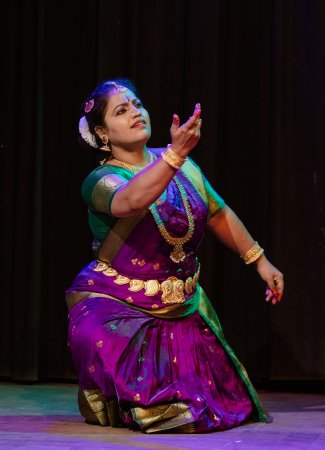 Rasika Pathak Rasika Pathak has a good rapport as colleague with Shamal for the 14 years at the Shardha Sangeet Vidyalaya. She performed an Abhang, Mazhe maher pandhari written by Saint Eknath. He says, 'Pandharpur is my mother's home, located on the banks of River Bheema. Vitthal is my father and Rakhumayee, my mother. Pundalika is my brother. What more can I tell about his greatness. My sister Chandrabhaga washes away the sins and purifies everyone!' Rasika presented the item with traditional padhartha bhava to the lyrics and danced to very evocative recorded music. It was a divine rendering of the Abhang and set all into a meditative ambience. 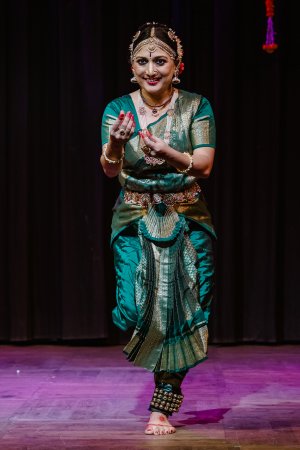 Samidha Shinde Samidha Shinde, who Shamal met at a workshop in Nalanda, presented an abhinaya piece Krishna nee begane (Yamunakalyani, mishrachapu) a popular devarnama by Vyasatirtha. The poem is an invocation to Krishna to come quickly, so that the devotee can enjoy his attributes and beauty. Here, as a prelude, Samidha showed Yashoda coaxing and cajoling Krishna to eat by showing him birds and animals and the nature around. Then she calls him to dress him up in choicest clothing, jewellery and sandalwood paste. She puts anklets on his feet saying that it would help to see and enjoy his beautiful dancing. She ties the belt around his waist and puts rings on his finger and appreciates how beautiful they looked on him. She ties his yellow colored dhoti, applies sandalwood paste and enjoys the special fragrance on him. Then she tries to adorn him with different necklaces but those are not liked by Krishna. Finally she makes the vyjayantimala with the kausthabha mani in it and ties it around his neck as chosen by Krishna himself. Later Krishna goes to play, but he is attracted to the mud. At first he takes a pinch of it and puts into his mouth; after a second pinch he looks round to see no one is looking and takes a handful and eats it up. This was very cutely performed. Then follows Krishna showing the world in his mouth to Yashoda. The joy of looking after a child Krishna was felt by all. This was performed to recorded music. The finale was the tillana (Hindolam, adi) in praise of Lord Muruga preceded by viruttam "Shadanam kumkuma raktha varnam". Shamal performed the viruttam and played the natuvangam for the thillana danced by her Sakhis. It was a traditional thillana structure with some intricate kanakku added to the mei adavus. Overall it kept to the relaxed ambience of the traditional thillana. The program had live music by Keerthana Krishnamurthy on vocals, nattuvangam and compering, Prajesh Nair on mridangam and Bhaskar on flute, plus recorded music. Lakshmi Anantanarayanan helped with rendition of the sollukattus of the varnam presented by Shamal Pawar. The program was well attended by family members, relatives and other fellow artistes. Above all, the presence of her first Guru Ambika Vishwanath was the icing on the cake for Shamal Pawar. 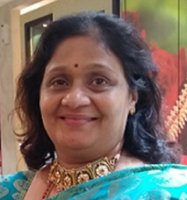 Chandra Anand is a Bharatanatyam artiste and teacher. She has an MA in Bharatanatyam from Tilak Maharashtra Vidyapeeth, and her series on 'Education in spiritual values through Bharatanatyam' is featured in narthaki.com. |